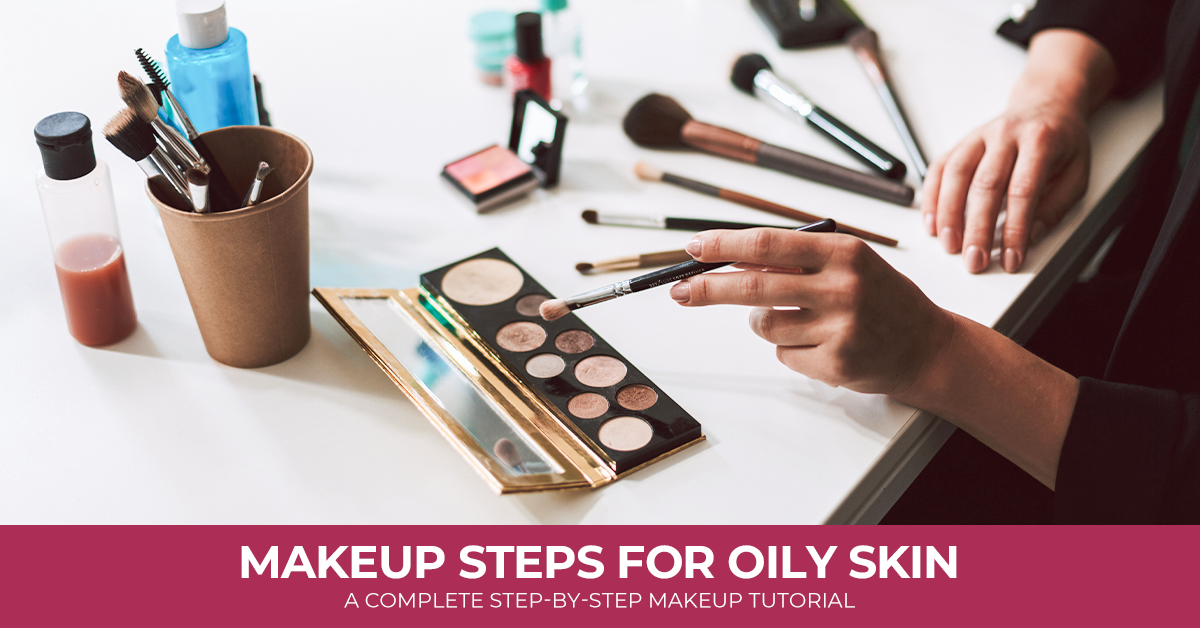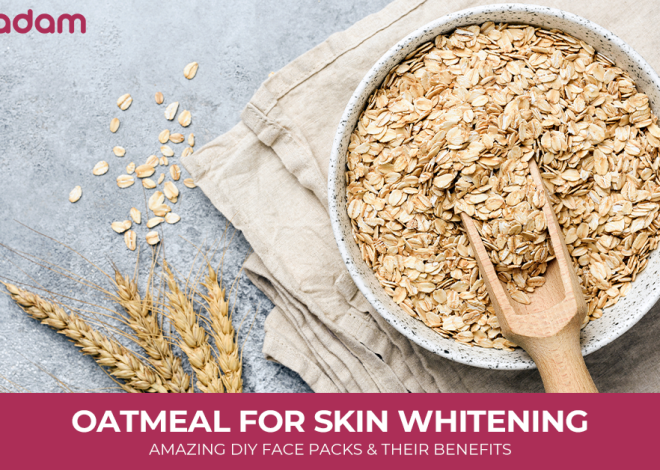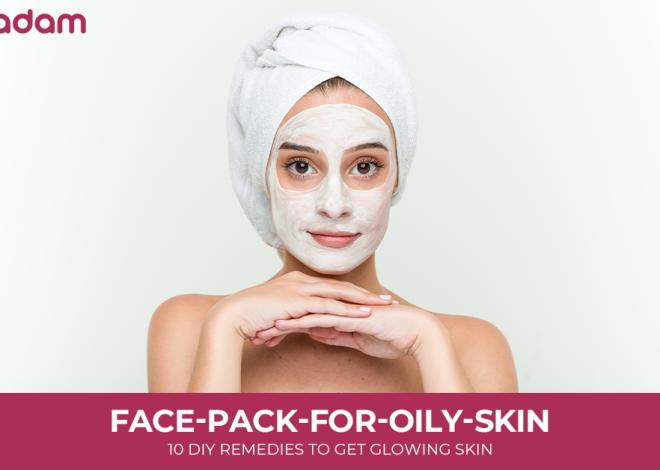
Makeup Steps for Oily Skin: A Complete Step-by-Step Makeup Tutorial
If you have oily skin, achieving a long-lasting makeup look is quite challenging. To help, here’s a comprehensive guide made specifically for oily skin types.
Whether you are looking for ways to control shine or to maximize the life of your makeup, this guide on makeup steps for oily skin will provide all the relevant information you need to achieve a flawless makeup look.
Table of Contents
What are The Best Makeup Products For Oily Skin?
Knowing about the makeup essentials will help you understand better how to apply makeup step by step for oily skin to achieve optimal results. Always Choose oil-free matte finish makeup products to control shine and prevent breakouts:
- Foundation: Choose matte-finish foundations that are oil-free, and non-comedogenic.
- Primer: Apply a primer to create a smooth, even base that will help makeup last longer if you have oily skin.
- Powder: Set your foundation with a matte powder to absorb excess oil and control shine throughout the day.
- Blush and Bronzer: Select matte formulas to avoid adding extra shine.
- Setting Spray: Finish applying a setting spray to help your makeup stay in place and control shine.
- Eye Makeup: Opt for waterproof formulas for eyeliner and mascara to prevent smudging.
More Information For You: Multani Mitti Face Pack for Oily Skin

13 Makeup Tips for Oily Skin
The following is a step-by-step makeup for oily skin routine to combat excess oil and ensure that your makeup stays fresh throughout the day:
1. Prep your skin properly.
Prepping your oily skin for makeup might cause a huge difference in the makeup outcome. Prep by cleansing your face to eliminate dirt, debris, and oil.
2. Hydrate Using a Lightweight Moisturizer
Hydrating your skin is important to balance out the oil for better makeup application. Select a lightweight and non-comedogenic moisturizer that absorbs quickly into the skin, offering enough hydration without clogging pores and adding extra shine.
3. Apply a light dusting of powder.
Applying a light dusting of loose powder on the T-zone before the foundation is the best way to avoid a patchy makeup application and prevent oiliness. The goal of this step is to absorb any excess oil that might interfere with your makeup application.
4. Apply a makeup primer.
Primer is the best way to control shine. The makeup primers formulated for oily skin are those that not only extend makeup wear but also keep shine at bay. Choose a formula that’s oil-free and non-comedogenic—these types tend to work best for those with oilier complexions.
5. Do Not Skip Eyelids
Though priming your face is important, also use an eye makeup primer to cover every inch of your face for flawless makeup. This step is important if you are wearing eyeshadow or eyeliner.
6 Select matte finish foundations
The optimal approach to applying foundation on oily skin includes using a liquid formula. Opt for a foundation that is known for its mattifying and long-lasting properties. This is to ensure a shine-free, uniform, and flawless finish.
7. Apply foundation in thin layers.
Use either a foundation brush or a makeup sponge to apply the foundation. Both are effective. But to avoid a cakey look, begin by applying a thin layer of foundation and go from there. You can always add more to parts that require a bit of additional coverage.
8. Layer your powders.
One of the important makeup steps for oily skin is to layer different types of powder to lock in your foundation with a mattifying finish. Start by dusting a translucent powder all over the face. Next, apply a powder puff and a brightening setting powder in the under-eye area and anywhere you want to brighten. Don’t forget to dust off excess powder to avoid a cakey finish.
9. Avoid luminous, dewy formulas.
The ideal makeup for oily skin should be more on the matte side. Do not use formulas that are too dewy and luminous. This will help keep shine to a minimum.
10. Use Powder Highlighters
If you have oily skin, stick to a powder highlighter and apply a light dusting only to the high points of your face (like on the top of your cheekbones, along your brow lines, and on Cupid’s bow). This helps add radiance without making your skin look more oily.
11. Apply a Mattifying Setting Spray.
To help extend the wear time of your face makeup and maintain a flawless finish all day long. Use a mattifying setting spray, reducing the need for touch-ups throughout the day.
12. Clean your makeup brushes regularly.
If you have oily skin, cleaning your makeup brushes often is crucial. Oils, bacteria, and leftover products can build up, leading to clogged pores and breakouts. Aim to wash them at least once a week with a gentle cleanser.
13. Touch Up Frequently with Blotting Paper
If your skin looks too shiny, use blotting papers. Gently press the paper onto your skin to absorb excess oil without messing up your makeup. This keeps your face matte and fresh.
These steps are nothing but a fair idea about how to do basic makeup for oily skin. Following them in your makeup routine will help keep your skin looking balanced, with no risk of a cakey finish.
Recommended You: Facial For Oily Skin At Home

Benefits of Applying Makeup on Oily Skin
After getting a clear picture of how to apply makeup step by step for oily skin, it’s time to explore the benefits. When done correctly, makeup can help control excess oil, provide a long-lasting matte finish, and enhance your overall look.
- Controls Shine: Matte foundations and setting powders can absorb excess oil, reduce shine, and provide a non-greasy look.
- Minimizes Pores: Primers and foundations formulated for oily skin can help blur the appearance of large pores, providing a more refined look.
- Improves Skin Texture: Makeup for oily skin helps even out skin tone and texture, covering redness, acne scars, or blemishes.
- Provides Long-Lasting Wear: Most oil-control or matte makeup products are designed to last longer, preventing the need for frequent touch-ups.
- Acts as a Protective Barrier: Properly applied makeup helps create a barrier against environmental pollutants and dirt to keep your skin clearer.
Is Liquid or Powder Foundation Better for Oily Skin?
For oily skin, powder foundation is generally considered better as it absorbs excess oil and provides a matte finish, while oil-free or non-comedogenic liquid foundations can also be a good option for those who prefer more coverage.
Here’s a more detailed breakdown:
Powder Foundation:
- Benefits: Powder foundations are known for their oil-absorbing properties that help to keep skin matte and shine-free throughout the day.
- Types: They are available in pressed or loose powder forms and are typically made from finely milled pigments and minerals.
- Considerations: Certain powder foundations can appear cakey or chalky if not applied correctly.
Liquid Foundation:
- Benefits: Liquid foundations provide more coverage and can help to even out skin tone and conceal blemishes.
- For Oily Skin: Look for oil-free or non-comedogenic formulas to avoid clogging pores.
- Considerations: Liquid foundations can sometimes feel heavier and can be more prone to settling into pores or lines.
Other Options:
- Stick Foundations: Stick foundations can be a good option for oily skin, more so if you prefer a creamier texture.
- CC Creams: CC creams are also a good option for oily skin, especially if you’re looking for a lightweight, natural-looking coverage.
Conclusion
If you have oily skin, it can be challenging to find makeup products that work well for your skin type. But, by incorporating these makeup steps for oily skin, you can keep your oily skin under control and enjoy a long-lasting, shine-free look. Most of these steps are centered around cleansing, applying primer and matte foundation, and helping you achieve your desired makeup look without a struggle.
FAQs
Which type of makeup is best for oily skin?
For oily skin, opt for oil-free, matte-finish makeup products to help control shine and prevent breakouts.
What constitutes natural makeup for oily skin?
For natural-looking makeup on oily skin, focus on oil-free, matte formulas, prioritize a good skincare routine, and use techniques like blotting papers and setting powder to control shine.
What to put on my face before makeup for oily skin?
Applying a face primer is crucial. The primer texture blurs imperfections and controls excess oil.
What is the best toner for oily skin?
Toners that are formulated with oil-controlling ingredients like niacinamide, green tea, witch hazel, or salicylic acid to manage excess oil and minimize breakouts.
How to choose a foundation for oily skin?
For oily skin, select a matte, oil-free, long-lasting foundation that controls shine and provides good coverage without feeling heavy.
Which makeup products should be avoided if I have oily skin?
If you have oily skin, you should generally avoid heavy, cream-based products, dewy foundations, and shimmery products, and instead opt for matte, oil-free formulas.
Which primer is best for oily skin?
For oily skin, a silicone-based, mattifying primer is generally recommended to control shine and create a smooth, long-lasting makeup base.
How to stop oily skin when wearing makeup?
Follow the makeup steps for oily skin discussed in the guide for a flawless, non-cakey makeup look.
What is the foundational skincare regime for oily skin?
Select oil-free or non-comedogenic skincare products to prevent clogged pores and breakouts.
Which ingredient is not good for oily skin?
- Occlusive Ingredients.
- Oleic Oils.
- Alcohol-Based Products.
- Silicones.



